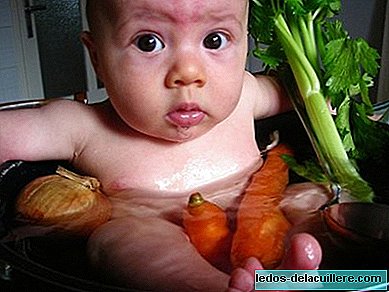
We continue our tour of the vegetables in the infant feeding. Today we bring a few Vegetables that are often used in the preparation of the baby's first porridge: carrot, tomato and celery.
There is a certain disparity in criteria regarding the age of introduction of the first two vegetables, since there are pediatricians who recommend them after six months and others who prefer to wait a little longer for their introduction.
Let's look at the reasons and analyze the properties of these vegetables and the best way to prepare the baby's food.
The carrot in infant feeding
Both carrot and celery belong to the Apiaceae family, consisting of several herbs and some shrubs, traditionally called umbellate.
The carrot is usually introduced at six or seven months into the baby's feeding, although some people delay it more because it accumulates nitrates. Although as we see later, it is also very rich in beta-carotene, a precursor to vitamin A, so it would be beneficial in that regard.
The Spanish Association of Pediatrics recommends avoiding foods that may contain many nitrates at the beginning, and includes carrots along with other vegetables (beets, spinach ...) that we will talk about in a next post.
Ideally, start by offering a small amount (if we put a lot, babies can change the color of the skin, especially the nose, which turns orange). A solution to avoid nitrates would be cook the carrot apart of the rest of the vegetables and discard the cooking water when preparing the mash, or steaming them.
Carrot is an excellent food from a nutritional point of view thanks to its vitamin and mineral content. Water is the most abundant component, followed by carbohydrates, with these nutrients providing energy. Being a root, it absorbs nutrients and assimilates them in the form of sugars. The content of these sugars decreases after cooking and increases with ripening.
Its characteristic orange color is due to the presence of carotenes, including beta-carotene or pro-vitamin A, an antioxidant compound that transforms into vitamin A once it enters our body.
It is also a source of vitamin E and vitamins of group B such as folates and vitamin B3 or niacin. Regarding minerals, the contribution of potassium, and discrete amounts of phosphorus, magnesium, iodine and calcium.
Some of the carrot nutritional components are: Water (g) 88.6 Carbs (g) 10.1 Lipids (g) 0.2 Calories (lime) 40 Vitamin A (IU) 2,000-12,000 Vitamin B1 (mg) 0.13 Vitamin B2 (mg) 0.06 Vitamin B6 (mg) 0.19 Vitamin E (mg) 0.45 Nicotinic acid (mg) 0.64 Potassium (mg) 0.1.
We recommend that you consult the pediatrician about the possibility of offering this vegetable to the baby by commenting on the points we have mentioned.
Tomato in infant feeding
Tomato is more allergenic than other vegetables and many children have rashes on the skin around the mouth (by contact), so we could assume a similar reaction in the stomach.
There is Pediatricians who recommend it after 12 months and others after 6 months, when they could already be included, cooked, in the baby's porridge. It can be introduced at that early age when we start the complementary feeding and if we observe any reaction in the baby's skin, remove it and delay it a few more months.
In any case, before cooking the tomatoes (or crushing them) we will have to peel them and remove the seeds (it is simple, with a spoon, raw, remove that part of the pulp that has the seeds). We will choose the most ripe tomatoes, because the greens are more indigestible and contain a toxic substance.
Tomatoes can be cooked boiled in water or steamed, and mix with other vegetables suitable for feeding the baby (broccoli, zucchini and squash, potatoes, green beans and peas ...), as well as meat or fish when we have already entered the baby's diet.
100 grams of tomato provide only 18 kcal. Most of its weight is water and then carbohydrates. It contains simple sugars that give it a slight sweet taste and some organic acids that give it the characteristic acid taste.
Tomato is an important source of certain minerals (such as potassium and magnesium, phosphorus, sodium iron ...). Vitamin A, B1, B2, B3, B5, B6 and vitamin C stand out from its vitamin content. It also has carotenoids such as lycopene (pigment that gives it the characteristic red color). Vitamin C and lycopene are antioxidants with a protective function of our body.
For all these properties it is an extremely nutritious food. As with the carrot, we recommend that you consult your pediatrician about the possibility of giving tomatoes to the baby, both cooked and raw in the form of juice, a modality for feeding the baby that we will discuss.
* Tomato juice.
In botanical terms, tomato is a fruit, and in many cases the boundaries between fruit and vegetables are not clear. That is why it does not sound so strange to us about tomato juice.
There are pediatricians who point out that you can give the baby natural tomato juice after six months, although we will try with a small amount, a juice lowered with water and using very ripe tomatoes without skin or seeds to see how the baby feels.
Never give the baby bottled tomato juice. These juices, prepared for the elderly, often have salt and pepper added, and may cause indigestion to the baby.
It is precisely due to the fragility of the digestive tract of the little one that special care is required so that the tomato juice adapts to his intestine without producing disorders: ripe tomatoes, without skin or pips, mixed with water and in a small amount.
Celery in infant feeding
As we have said, celery belongs to the same family as carrots (Apiaceae), although this vegetable does not accumulate nitrates as much as the previous one.
Therefore with respect to celery there are no restrictions when it comes to introducing it into the baby's diet after 6 months, but only using the broth, the substance that releases the vegetable when cooked: we will not crush it. When crushing vegetables, celery must be left out, because it is very filamentous and can be difficult to digest.
We will crush the rest of the vegetables by removing the celery, although its nutritional properties and the characteristic flavor will have passed into the water we use for the porridge.
Celery is suitable in the human diet due to its high content of dietary fiber, vitamins and minerals, in addition to being considered a good diuretic due to the high percentage of water.
The composition (per 100 grams) is: Water: 95 g, Energy: 57 kJ, Protein: 0.7 g, Fat: 0.2 g, Carbohydrates: 3 g, Sugars: 2 g, Fiber: 1.6 g, Vitamin C: 3 mg
Celery is rich in minerals (potassium, sodium, magnesium, iron, sulfur, phosphorus, manganese, copper ...) and rich in vitamins (A, C, E and B).
Vegetable preparation mode
We have already given the basic data for each of the commented vegetables: boil the carrot apart To avoid nitrate accumulation, peel and remove the seeds from tomatoes and not crush the celery to make the porridge.
Tomato and carrot can be cooked boiled or steamed, but celery needs cooking in water, because it is precisely the substance that leaves in the water that interests us to make the porridge, and not the vegetable itself.
When mashing the mash, add enough water so that it has a smooth consistency, although little by little you have to keep larger pieces and let the baby take the cooked vegetables by hand and eat.
As we have said in the other entries dedicated to vegetables, it is not convenient to reheat the mash from one time to another. What is not going to be consumed is better to separate it before and store it in the fridge or freeze it if it is not going to be consumed in the next 24 hours.
Following all these tips we will achieve that Vegetables as healthy as tomatoes, celery and carrots begin to be part of infant feeding.












